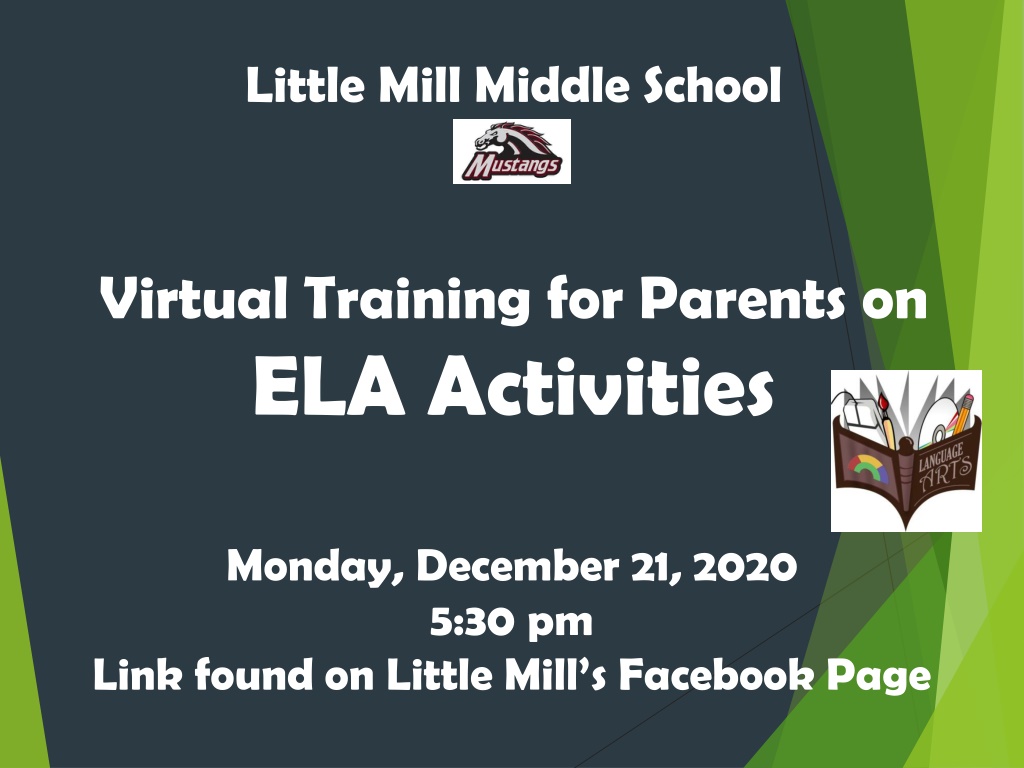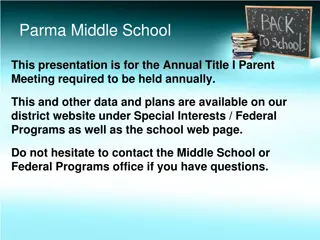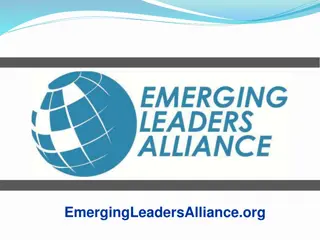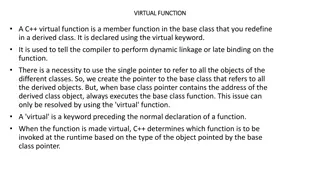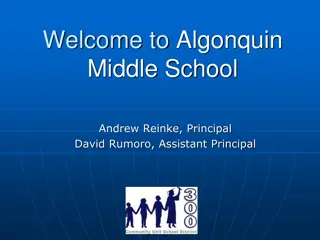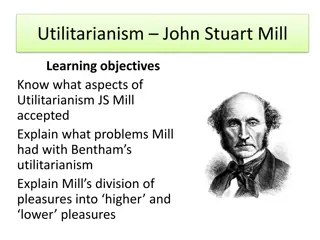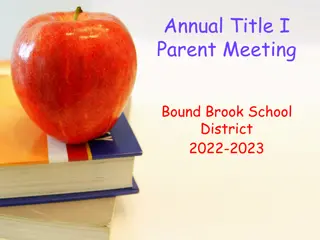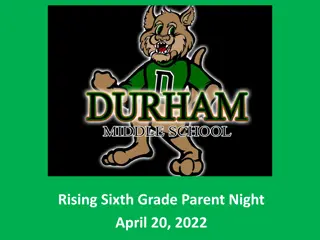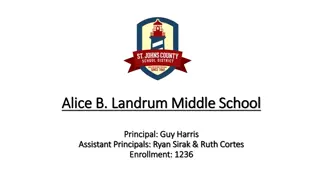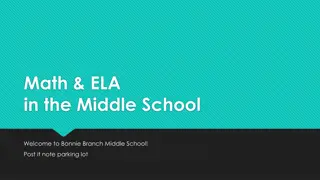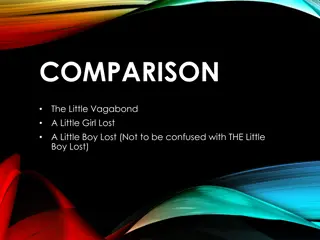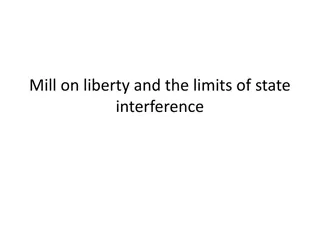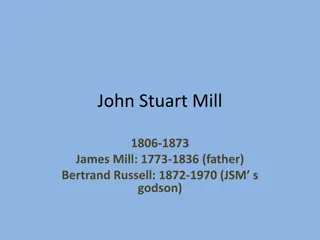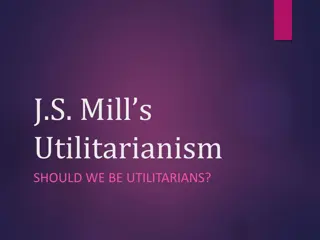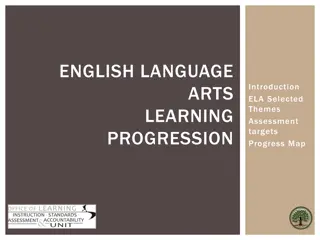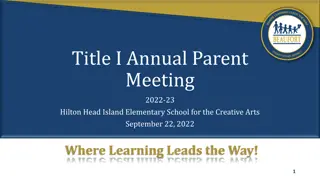Little Mill Middle School Title I Virtual ELA Training for Parents
On Monday, December 21, 2020, at 5:30 pm, Little Mill Middle School is hosting a virtual training session for parents on English Language Arts activities. The event, facilitated by Title I staff, aims to enhance family engagement and provide insight into how students benefit from Title I funding. The program ensures equitable access to resources like iPads, laptops, books, and learning tools. Parents are encouraged to practice vocabulary with their children based on Georgia Milestones standards. Further details and materials are available on the school's website.
Download Presentation

Please find below an Image/Link to download the presentation.
The content on the website is provided AS IS for your information and personal use only. It may not be sold, licensed, or shared on other websites without obtaining consent from the author. Download presentation by click this link. If you encounter any issues during the download, it is possible that the publisher has removed the file from their server.
E N D
Presentation Transcript
Little Mill Middle School Virtual Training for Parents on ELA Activities Monday, December 21, 2020 5:30 pm Link found on Little Mill s Facebook Page
Little Mill Title 1 Staff Kari Shepherd Lead Teacher Jackie Suddith Language Arts Anne Marie Sasser Family Engagement Coordinator
How do Little Mill students benefit from Title 1 funding?
Little Mill Middle School is identified as school wide Title I as part of the Elementary and Secondary Education Act of 1965(ESEA). A school wide Title I program ensures the success of all students. Everyone has access to the numerous resources and materials purchased with Title I funds, including I Pads, laptops, computer programs, books, manipulatives, and learning games. Because of Title I, you and your child have access to excellent resources and enriching programs.
English/Language Arts standards can be found at www.georgiastandards.org In addition, important information regarding all curricula can be found at gadoe.org in the Information for Parents section
Language Arts Focus: How can parents truly help students at home with language arts? Practice VOCABULARY with your students!!!!!!
The VOCABULARY that we will focus on includes the common English/Language Arts terms that 6th, 7th, and 8th grade students need to be familiar with for the GA Milestones. *** A list of these terms and other materials are available to parents on our Title 1 page on the school s website
Georgia Milestones Language Arts Vocabulary Word List A Definition To infer means to come to a reasonable conclusion based on evidence found in the text. By contrast, an explicit idea or message is fully stated or revealed by the writer. The author tells the reader exactly what they need to know. Inference The theme of a literary text is its lesson or message. For example, a story could be about two friends who like to do things together, and the theme might be the importance of friendship. Theme The series of events that form a story in a specific order. Plot In most stories there is a conflict or problem. The resolution is the solution to the problem or the end of the main dramatic conflict. Resolution To understand figurative language, you need to distinguish between literal and figurative meanings of words and phrases. Literal refers to the actual meaning of a word or phrase. For example, if someone tells you to open the door, you can open a physical door. If someone tells you to open the door to your heart, you are not expected to find a door in your chest. Instead, you open up your feelings and emotions. Examples of figurative language are similes and metaphors. Figurative Language Make comparisons using a linking word such as like, as, or than (her eyes shone like the stars). Similes Makes a comparison without a linking word; instead of one thing being like another, one thing is another (her eyes were shining stars). If someone says the sea was glass, they are using a metaphor. The sea was calm, smooth, and clear; it was not literally glass. Metaphor
Word List B Definition When a writer describes an object as if it were a person. For example, The trees sighed in the afternoon breeze. The trees did not really sigh but seemed to as they blew gently in the breeze. Personification The perspective from which a story is told. The point of view depends upon who the narrator is and how much he or she knows. The point of view could be first person (I went to the store), second person (You went to the store), or third person (He went to the store). Point of View Though similar, comparing is analyzing two things such as characters or stories in relation to each other, while contrasting is specifically analyzing the differences between two things such as two different characters or stories. Compare vs. Contrast A genre is a category of passages, such as fiction and nonfiction. Each genre has a particular style, form, and content. Genre A summary is an overview of a text that captures the main points but does not give all of the details and does not include opinions. Summary A meaning beyond the explicit meaning of a word. For example, the word childlike connotes innocence as well. Connotations are meanings inferred from certain words. Connotative Meaning The way in which a piece of writing is structured. Each sentence, paragraph, or chapter fits into the overall structure of a text and contributes to the development of ideas. Organization The author s intention for his or her piece. All passages have a purpose, whether it is to persuade, inform, explain, or entertain. Author s Purpose The opinion of the author. Your opinion may differ from the opinion of the author writing a passage. Author s Point of View Something that proves or demonstrates the truth of something else. Informational texts may contain evidence to prove that the information they are providing is correct. Evidence
Word List C Definition A fact is a statement that can be proven. An opinion is a statement that cannot be proven because it states a writer s belief or judgment about something. Deciding whether or not a statement is a fact or an opinion often comes down to a single question: Can you prove it? If you can prove a statement, then it is a fact. If not, it s an opinion. Fact and Opinion The order in which a series of events happened. A text that is arranged in order of time from the beginning to the end is in chronological order. Chronological Order This is a relationship where one thing causes another thing to happen. A passage may also be organized by stating the problem and solution as well. Cause and Effect Ideas and opinions set forth by the author. For example, a writer could make the claim that the school cafeteria is too expensive. Claims The evidence given to support a writer s claims. For example, a writer could include information on the price of school lunch or the number of students who don t want to buy it as reasons to support the claim that the school cafeteria is too expensive. Reasons The ways in which ideas are connected. Writing should use words, phrases, and clauses to clarify the relationships among claims and reasons. Relationships The writer s intention for his or her piece. All writing has a purpose, whether it is to persuade, inform, explain, or entertain. Purpose A variety of mediums. Writing does not only include pen-to-paper or a typed essay. Other ways of enhancing writing can include mediums such as art, presentations, photographs, charts, videos, and more. Multimedia
Word List D Definition The way in which a piece of writing is structured. Similar ideas and illustrations should be grouped together and the order of the information should make sense. Organization In writing, the organization helps explain ideas and information more clearly. Writers use transitions to organize information. Also, an entire piece of writing has an organizational structure to it. Writers structure their texts to match their purpose and audience. For example, if you were writing an argumentative text in which you wanted to show the negative effects of something, you might choose cause and effect as an organizational structure. The process of editing and rewriting a piece of writing. All good writing requires a lot of revision in order to catch mistakes and clarify ideas. Revision Informational / Explanatory Texts Texts that are forms of writing that inform the reader or explain something. The beginning of a piece of writing. The introduction should let readers know what they will be reading about and set up the main idea of the writing. Introduction A word, phrase, or clause that links one idea to the next. Writing should not jump from one idea to the next without transitions that guide the reader to the next idea. Examples include words such as another, for example, also, and because. Transition The end of a piece of writing is the conclusion. The conclusion should sum up the main idea of the writing and provide an overall message for the reader. Conclusion The way in which a piece of writing is organized. For example, a writer can use headings and subheadings to organize the writing and present the information in a clear way. Formatting
Word List E Definition Most informational or technical pieces require hard work and revision before they can be considered ready. Drafting, revising, editing, and proofreading your writing are all essential parts of an effective writing process. The steps in the writing process are prewriting, drafting, revising and editing, proofreading, and publishing. Writing Process Pronouns that act as the subject of a sentence. Examples are I, we, he, she, and they. In the sentence They went to the beach, they is the subject in the subject- verb-object structure. Subjective / Nominative Pronoun Pronouns that act as the object of a sentence. Examples are me, us, him, her, and them. In the sentence, He gave it to them, them is the object in the subject- verb-object structure. Objective Pronoun Pronouns that show possession. Examples are mine, his, hers, ours, and theirs. For example, Those cookies are mine. Possessive Pronoun Pronouns that represent an object that may have already been identified or does not need explicit identification. Examples are another, any, both, each, neither, none, and some. Indefinite Pronoun Writing marks that help to separate and clarify ideas. Examples of punctuation are the period, comma, colon, exclamation mark, and question mark. Punctuation The particular form or way an author chooses to write. There are many different writing styles. It is important to maintain your style throughout a piece of writing. Style Words and phrases that surround another phrase and help to explain its meaning. Sometimes a word cannot be understood without the context of the words and phrases around it. For example, he threw it could mean several things, but when the full sentence is included, He threw the basketball up high from midcourt and sunk it through the hoop for two points, the meaning is clear. Context
Vocabulary Shot Basketball Game Vocabulary Shot The Rules: Divide the group into two teams. Each member of the team is asked a vocabulary question (definition, spelling, pronunciation, etc.). If the player gets the answer right, he wins a point for his team, and he has the chance of getting another question if he s able to make a basketball shot. If the player makes the shot, he s asked another question. If he gets that right, he has another chance at the basketball shot, but this time he must take a step or two back. This continues until the player misses a shot or gets a question wrong. In either case, the next question goes to the other team. After everyone has had a turn, the team with the most points wins. Materials Needed: Foam basketball and hoop (or paper waste basket) List of vocabulary words
Vocabulary Cubes Dice Game
Tip for Parents Access Parent Portal and itslearning * You can set up your own account by bringing in your ID to the front office and asking for the official link to be sent to your email Communicate with your student s teachers Talk to your student and ask questions
Parent Feedback Please provide us with some feedback and email Anne Marie Sasser, Family Engagement Coordinator at amsasser@forsyth.k12.ga.us Was the information you received useful? What other topics would you like more information on? What trainings/ classes would you be interested in ? What trainings would you like for teachers to participate in so that we can better serve your family?
